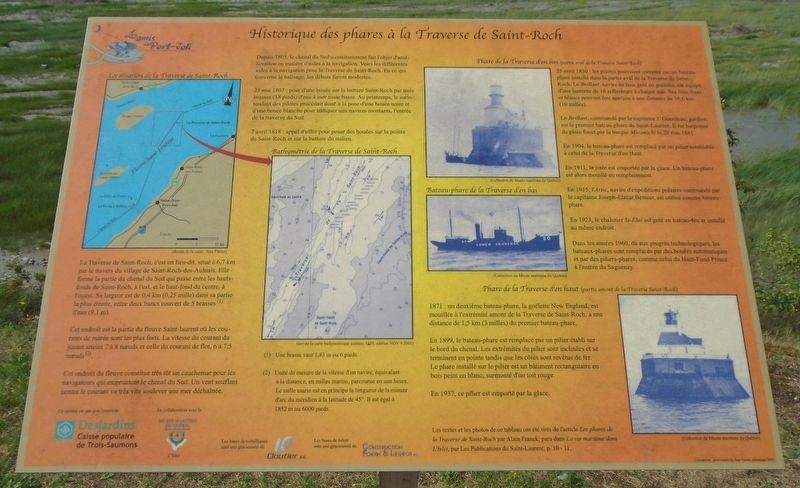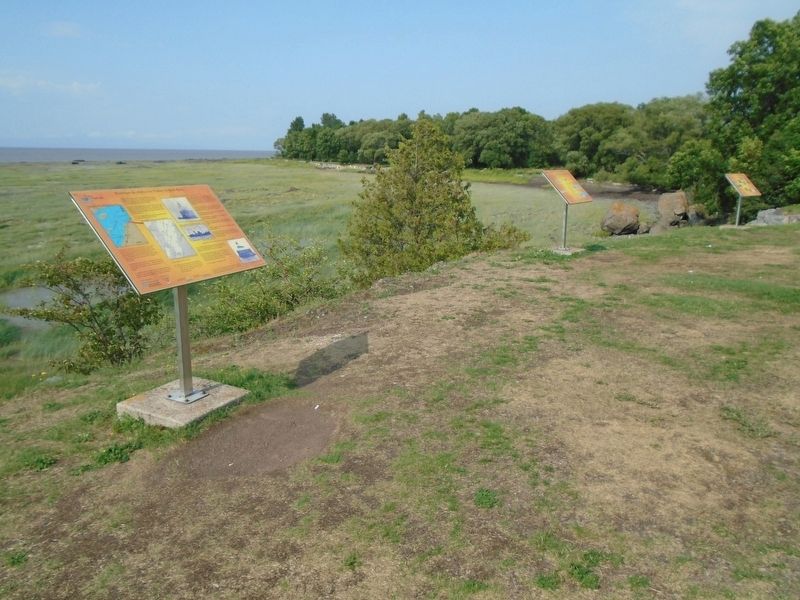Saint-Jean-Port-Joli in Chaudière-Appalaches, Québec — Central Canada (French-Canadian)
Historique des phares à la Traverse de Saint-Roch
History of the Saint-Roch Traverse Lighthouses
Inscription.
Depuis 1805, le chenal du Sud a constamment fait l'objet d'amélioration en matière d'aides à navigation. Voici les différentes aides à la navigation pour la Traverse de Saint-Roch. En ce qui concerne le balisage, les débuts furent modestes.
23 mai 1807 : pose d'une bouée sur la batture Saint-Roch par trois brasses (18 pieds) d'eau à mer toute basse. Au printemps, le surintendant des pilotes procédait donc à la pose d'une bouée noire et d'une bouée blanche pour indiquer aux navires montants, l'entrée de la traverse du Sud.
7 avril 1818 : appel d'offre pour poser des bouées sur la pointe de Saint-Roch et sur la batture du milieu.
[Plans]
• Localisation de la Traverse de Saint-Roch
• Bathymétrie de la Traverse de Saint-Roch
La Traverse de Saint-Roch, e'est un lieu-dit, situé à 6,7 km par le travers du village de Saint-Roch-des-Aulnais. Elle forme la partie du chenal du Sud qui passe entre les hauts-fonds de Saint-Roch, à l'est, et le haut-fond du centre, à l'ouest. Sa largeur est de 0,4 km (0,25 mille) dans sa partie la plus étroite, entre deux bancs couvert de 5 brasses (1) d'eau (9,1 m).
Cet endroit est la partie du fleuve Saint-laurent où les courants de marée sont les plus forts. La vitesse du courant du jusant atteint 7 à 8 nœuds et celle du courant de flot, 6 à 7,5 nœuds (2).
Cet endroit du fleuve constitue très tôt un cauchemar pour les navigateurs qui empruntent le chenal du Sud. Un vent souflant contre le courant va très vite soulever une mer déchaînée.
(1) : Une brasse vaut 1,83 m ou 6 pieds.
(2) : Unité de mesure de la vitesse d'un navire, équivalant à la distance, en milles marins, parcourue en une heure. Le mille marin est en principe la longueur de la minute d'arc du méridien à la latitude de 45°. Il est égal à 1852 m ou 6000 pieds
Phare de la Traverse d'en bas (partie aval de la Traverse Saint-Roch)
25 avril 1830 : les pilotes pouvaient compter sur un bateau-phare installé dans la partie aval de la Traverse de Saint-Roch. Le Brillant, navire en bois gréé en goélette, est équipé d'une lanterne de 16 réflecteurs à chaque mât. Ses feux fixes et blancs peuvent être aperçus à une distance de 16,6, km (10 milles).
Le Brillant, commandé par le capitaine J. Gourdeau, gardien, est le premier bateau-phare du Saint-Laurent. Il fut harponné de plein fouet par
la barque Miramichi le 20 mai 1841.
En 1904, le bateau-phare est remplacé par un pilier semblable à celui de la Traverse d'en Haut.
En 1911, la jetée est emportée par la glace. Un bateau-phare est alors mouillé en remplacement.
En 1915, l'Artic, navire d'expéditions polaires commandé par le capitaine Joseph-Elzéar Bernier, est utilisé comme bateau-phare.
En 1923, le chalutier St-Éloi est gréé en bateau-feu et installé au même endroit.
Bateau-phare de la Traverse d'en bas
Dans les années 1960, dû aux progrès technologiques, les bateaux-phares sont remplacés par des bouées automatiques et par des piliers-phares, comme celui du Haut-Fond Prince à l'entrée du Saguenay.
Phare de la Traverse d'en haut (partie amont de la Traverse Saint-Roch)
1871 : un deuxième bateau-phare, la goélette New England, est mouillée à l'extrémité amont de la Traverse de Saint-Roch, à une distance de 1,5 km (3 milles) du premier bateau-phare.
En 1899, le bateau-phare est remplacé par un pilier établi sur le bord du chenal. Les extrémités du pilier sont inclinées et se terminent en pointe tandis que les côtés sont revêtus de fer. Le phare installé sur le pilier est un bâtiment rectangulaire en bois peint en blanc, surmonté d'un toit rouge.
En 1937, ce pilier est emporté par la glace.
Les textes et les photos de ce tableau ont été tirés de l'article Les phares de la Traverse de Saint-Roch par Alain Franck, paru dans La vie maritime dans L'Islet, par Les Publications du Saint-Laurent, p. 10 - 11.
Since 1805, the southern channel has been constantly improved in terms of navigational aids. Here are the various navigation aids for the Saint-Roch Traverse. In terms of markup, the beginnings were modest.
May 23, 1807: laying a buoy on the Saint-Roch barrage at three fathoms (18 feet) of water at low tide. In the spring, the Superintendent of Pilots proceeded to lay a black buoy and a white buoy to indicate to transiting ships the entrance to the south transom.
April 7, 1818: call for tenders to lay buoys on the Saint-Roch Pointe and on the middle slope.
[Maps]
• Location of the Saint-Roch Traverse
• Bathymetry of the Saint-Roch Traverse
The Saint-Roch Traverse, is a locality, located 6.7 km from the village of Saint-Roch-des-Aulnais. It forms the part of the southern channel that passes between the shoals of Saint-Roch in the east, and the center shoal, to the west. Its width is 0.4 km (0.25 mile) in its narrowest part, between two benches[?] covered by 5 fathoms(1) of water (9,1 m).
This place is the part of the St. Lawrence River where the tidal currents are the strongest. The current velocity of the ebb reaches 7 to 8 knots and that of the stream current is 6 to 7.5 knots(2).
This place in the river was an early nightmare for sailors who used the southern channel. A blowing wind against the current will quickly lift a raging sea.
(1): One fathom is 1.83 m or 6 feet.
(2): Unit of measure of the speed of a ship, equivalent to the distance, in nautical miles, traveled in one hour. The nautical mile is in principle the length of the arc minute of the meridian at 45° latitude. It is equal to 1852 m or 6000 feet
The Traverse Lighthouse from below (downstream part of the Saint-Roch Traverse)
April 25, 1830: the pilots could count on a lightship installed in the downstream part of the Saint-Roch Traverse. The Brillant, a wooden schooner, was equipped with a lantern of 16 reflectors on each mast. Its fixed white lights could be seen at a distance of 16.6 km (10 miles).
The Brillant, commanded by Captain J. Gourdeau, lightkeeper, was the first lightship on the St. Lawrence. It was severely harpooned by the boat Miramichi May 20, 1841.
In 1904, the lightship was replaced by a pillar similar to that at the Haut Traverse.
In 1911, the pillar was washed away. A lightship then went in as a replacement.
In 1915, the Artic, ship of polar expeditions commanded by Captain Joseph-Elzéar Bernier, was used as a lightship.
In 1923, the trawler St-Éloi was rigged as a fireboat and installed in the same place.
In the 1960s, due to technological progress, the lightship was replaced by automatic buoys and pillars, such as the Haut-Fond Prince light station at the entrance to the Saguenay [River].
1871: A second lightship, the schooner New England, was anchored at the upstream end of the Saint-Roch Traverse at a distance of 1.5 km (3 miles) from the first lightship.
In 1899, the lightship was replaced by a pillar established on the edge of the channel. The ends of the pillar were sloping and ended in a point, while the sides were covered with iron. The lighthouse installed on the pillar was a rectangular building in white painted wood, topped with a red roof.
In 1937, this pillar was washed away by the ice.
The texts and photos on this marker were taken from the article Les phares de la Traverse de Saint-Roch by Alain Franck, published in La vie maritime in L'Islet, by Les Publications du Saint-Laurent, p. 10-11.
Erected 2007 by Desjardins Caisse populaire de Trois-Saumons, le musée maritime du Québec, et al.
Topics and series. This historical marker is listed in these topic lists: Communications • Waterways & Vessels. In addition, it is included in the Lighthouses series list. A significant historical year for this entry is 1805.
Location. 47° 10.817′ N, 70° 18.247′ W. Marker is in Saint-Jean-Port-Joli, Québec, in Chaudière-Appalaches. Marker is on Avenue de Gaspé Ouest (Québec Route 132) 3 kilometers south of route des Bourgault, on the right when traveling south. Touch for map. Marker is at or near this postal address: Parc Halte des Piliers, Saint-Jean-Port-Joli QC G0R 3G0, Canada. Touch for directions.
Other nearby markers. At least 8 other markers are within 5 kilometers of this marker, measured as the crow flies. Historique du phare de La Roche à Veillon (here, next to this marker); Historique du phare du Pilier de Pierre (a few steps from this marker); Beaumont-la-Ronce et Anse de Nouzilly (within shouting distance of this marker); Église de Saint-Jean-Port-Joli (approx. 4.7 kilometers away); Place de l'Église (approx. 4.7 kilometers away); Hommages à la Congrégation des Soeurs de Saint-Joseph de Saint-Vallier (approx. 4.8 kilometers away); Les Trois Berets / The Three Berets (approx. 4.8 kilometers away); Les Anciens Canadiens / The Canadians of Old (approx. 4.8 kilometers away). Touch for a list and map of all markers in Saint-Jean-Port-Joli.
Also see . . . Phares du Saint-Laurent at Wikipedia. (Submitted on September 28, 2018, by William Fischer, Jr. of Scranton, Pennsylvania.)
Credits. This page was last revised on January 23, 2022. It was originally submitted on September 28, 2018, by William Fischer, Jr. of Scranton, Pennsylvania. This page has been viewed 265 times since then and 22 times this year. Photos: 1, 2. submitted on September 28, 2018, by William Fischer, Jr. of Scranton, Pennsylvania.

